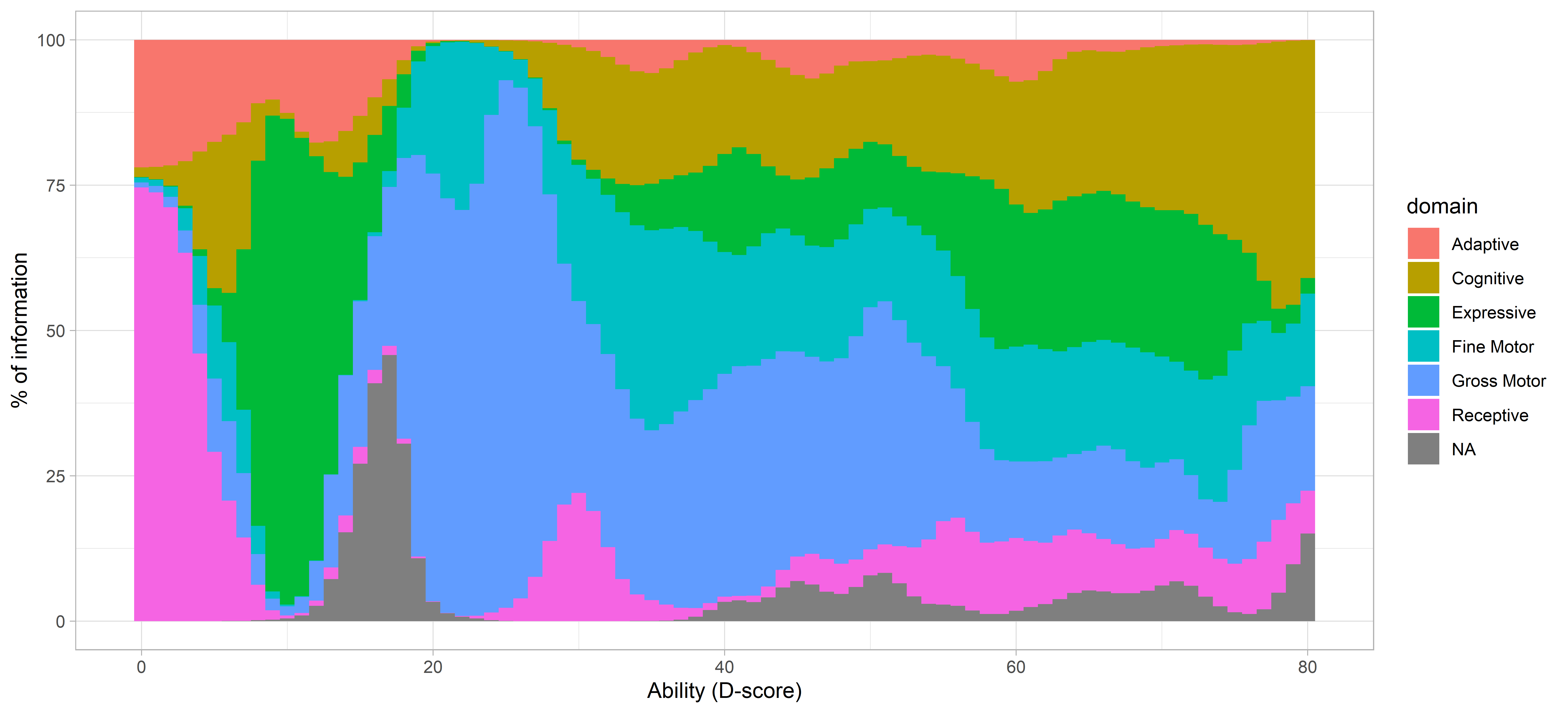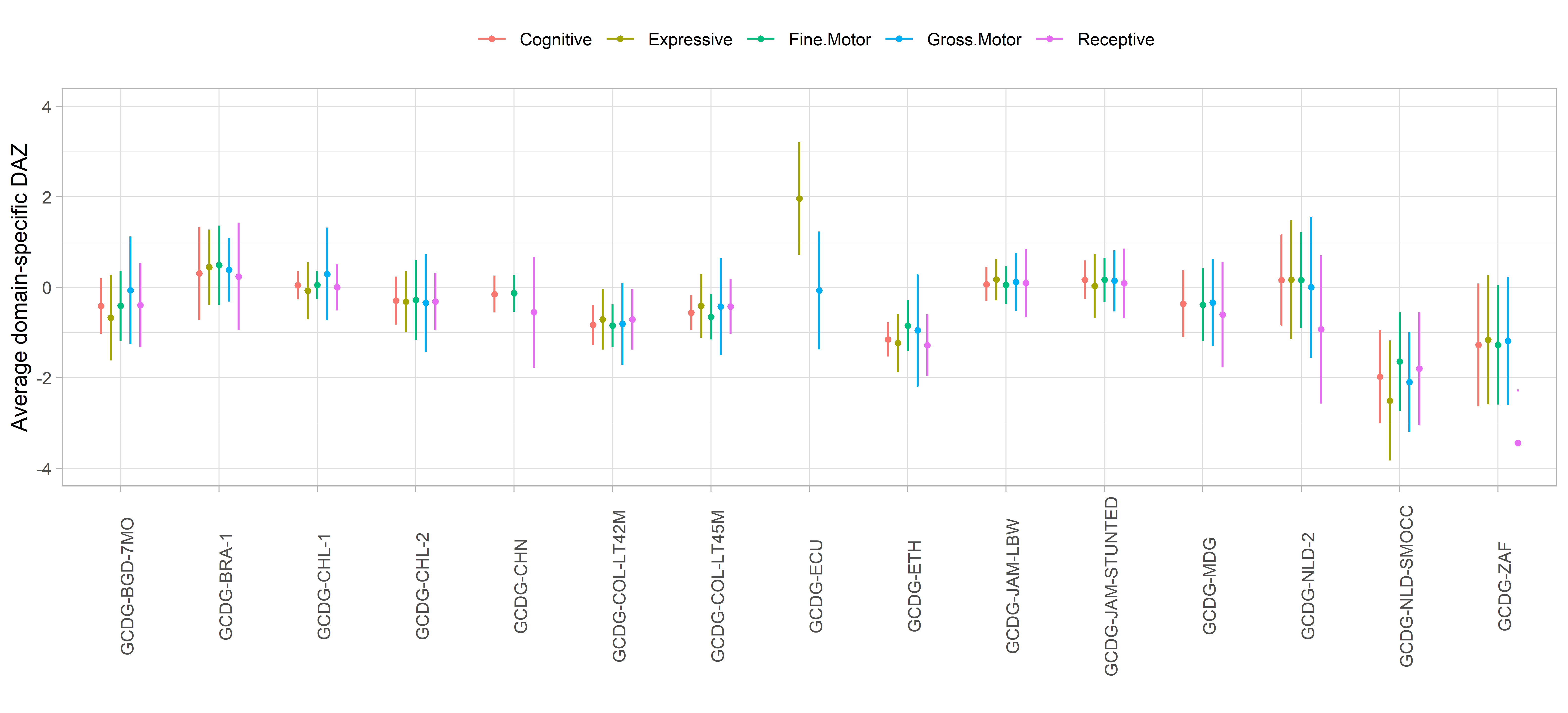6.3 Domain coverage
The D-score is a one-number summary of early child development. Traditional instruments distinguish domains (like motor, communication, language and cognitive development) and some provide ways to calculate a total score. The D-score, on the other hand, is based on the notion that child development is a unidimensional latent construct and hence does not provide domain scores. And thus, the question is how the D-score represents domains.
This section explores the following two questions:
- Can we break down the D-score by domain contribution, and if so, can we evaluate whether the D-score fairly represents all domains?
- Can we calculate domain-specific D-scores?
6.3.1 Domain coverage of the scale
For many items in the D-score model, we had expert information available as to which domain the item belongs. For each item, we calculated the proportion of times the experts assigned it to one of five domains: Fine Motor, Gross Motor, Expressive, Receptive, Cognitive. We then calculated the distribution of domain by age.

Figure 6.7: Domain coverage of the D-score scale.
Figure 6.7 shows the domain composition of the D-score across different levels of ability. Note that we miss domain information for a few items. The share of gross-motor is large in early development (e.g., between 15 and 30 months), and gradually tapers off at higher levels. Reversely, the percentage of cognition and language is relatively small before 30 months but rapidly rises as the child matures. These transitions in domain composition look both reasonable and valid.
6.3.2 Domain-specific D-scores
Suppose we select a domain of interest and calculate the D-score only from items that substantially load onto that domain. We then get a domain-specific D-score. Items that relate to multiple domains contribute to multiple domain-specific D-scores.

Figure 6.8: Average domain-specific DAZ \(\pm\) sem by cohort.
Figure 6.8 displays the standardized domain-specific D-score (i.e. DAZ) per cohort. The DAZ strips out irrelevant age variation, and thus enhances comparability between cohorts. The error bars around the scores depict the sem interval. We observe some variation in domain-specific DAZ scores within cohorts. Still, these differences are relatively small and well within the margins of error. This analysis suggests that the D-score is an excellent overall summary of the domain-specific D-scores.
The D-score methodology assumes that child development is a unidimensional scale. As a consequence, the correlations between different domain-specific D-scores are extremely high (\(r > 0.95\)). It is more interesting to study the correlation between the DAZ equivalent of the domain-specific scores.
| DAZ | Fine.motor | Gross.Motor | Cognitive | Receptive | Expressive |
DAZ | 1.00 | 0.69 | 0.57 | 0.84 | 0.70 | 0.69 |
Fine motor | 0.69 | 1.00 | 0.40 | 0.74 | 0.50 | 0.39 |
Gross Motor | 0.57 | 0.40 | 1.00 | 0.43 | 0.34 | 0.30 |
Cognitive | 0.84 | 0.74 | 0.43 | 1.00 | 0.76 | 0.59 |
Receptive | 0.70 | 0.50 | 0.34 | 0.76 | 1.00 | 0.63 |
Expressive | 0.69 | 0.39 | 0.30 | 0.59 | 0.63 | 1.00 |
Table 6.2 lists the Pearson correlation matrix of the DAZ and the five domain-specific DAZ scores. All correlations between the DAZ and the domain-specific scores are high, thus confirming the generic character of the D-score and DAZ. We find high inter-domain correlations for the cognitive-receptive, cognitive-fine motor and expressive-receptive pairs. The gross motor domain appears as somewhat distinct from the four other domains. Its position may be genuine, but could also be related to the smaller number of responses on gross motor milestones in the GCDG data.

Figure 6.9: Domain-specific D-scores for a 3 year old boy.
Figure 6.9 displays individual scores for a 3 year old boy. The filled bars indicate the number of available items per domain. The vertical white line that crosses the horizontal axis at value 5 indicates a threshold for a minimum number of items needed for a D-score. Note that the number of items for Gross Motor in this example is meagre (only three items). The grey vertical line indicates the value of the overall D-score (68.55\(D\)). The nearby dashed lines are located at one sem (0.53\(D\)) distance. The coloured points are the domain-specific D-scores with the sem around in error bars. The plot visualises that the boys’ scores on language domains (i.e. Expressive and Receptive) are low as compared to the motor and cognitive domains. A systematic discrepancy between various domain-specific scores might be an early warning sign for developmental delay.